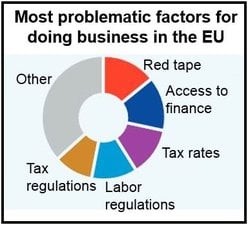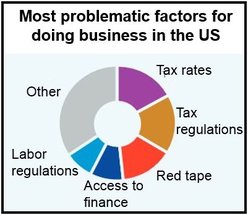The World Competitiveness Report 2014-2015, published by the World Economic Forum (WEF) was released today. The WEF warns that despite several years of bold monetary policy reforms, the health of the world economy is at risk.
The Report assesses factors driving the productivity and prosperity of each nation. It found that the greatest challenge to long-term global growth is the uneven way structural reform has been implemented in different regions and levels of development.
Leaders in both the private and public sectors need to collaborate more effectively in the areas of talent and innovation, the authors wrote.
Below is a list of the ten most competitive nations in the world, and how their rankings have changed compared to last year (in brackets):
- 1. Switzerland (1) has maintained top stop for the last six years.
- 2. Singapore (2)
- 3. United States (5). The US has climbed up in the ranking for the second year running. This year it has jumped two places “on the back of gains to its institutional framework and innovations scores.”
- 4. Finland (3)
- 5. Germany (4)
- 6. Japan (9)
- 7. Hong Kong SAR (7)
- 8. Netherlands (8)
- 9. United Kingdom (10)
- 10. Sweden (6)
The top 10 most competitive nations scored particularly well in developing, accessing and utilizing available talent, as well as investing in projects that promote innovation.

These well targeted investments have been the result of a coordinated approach based on close cooperation between the private and public sectors.
Europe – good and bad news
Several European countries that suffered badly during the Great Recession, such as Greece (81st), Portugal (36th) and Spain (35th), have made considerable improvements in the functioning of the markets and allocation of productive resources.
On the other hand, France (23rd) and Italy (49th) continue to face significant competitiveness challenges, and “do not appear to have engaged in this process.”
There is still a wide gap between the competitive North and lagging South & East.
However, another divide has become evident – one between countries that have implemented reforms and those that have not.
Emerging markets
Several emerging market economies fell in the ranking, including:
- Brazil 57th
- India 71st
- Mexico 61st
- Nigeria 127th
- Saudi Arabia 24th
- South Africa 56th
- Turkey 45th
China, on the other hand, climbed one position to 28th, and is again the highest-ranking BRICS country.

Asia – a region of contrasts
Asia has the widest gap in competitiveness. Behind second-place Singapore, Vietnam (68th), the Philippines (52nd), Indonesia (34th), Thailand (31st) and Malaysia (20th) have improved in the rankings.
Since 2010, the Philippines is the most improved country overall.
Among the South Asian markets, only India made it to the top half.
Latin America must push reforms
If Latin America wants to boost its economic resilience and maintain the economic momentum of the last few years, its major economies need to implement reforms and engage in productive investments to improve innovation, skills and infrastructure.
In 33rd place, Chile leads in the region, followed by Panama (48th) and Costa Rica (51st).
Middle East & North Africa
Impacted by geopolitical instability, the region portrays a mixed picture.
Having moved up seven places to 12th, the United Arab Emirates heads the region, followed by Qatar (16th).
North Africa lags far behind, with only one country – Morocco (72nd) – managing to rank in the top half. “Ensuring structural reforms, improving the business environment, and strengthening the innovative capacity so as to enable the private sector to grow and create jobs are of key importance to the region,” the authors wrote.
Sub-Saharan Africa
Growth rates in the region at nearly 5% have been impressive. In order to maintain the expansion, countries must move towards more productive activities and address the persistent competitiveness problems.
Only Mauritius (39th), South Africa (56th) and Rwanda (62nd) made it to the top half in the rankings.
The region’s greatest challenge is to address the human and physical infrastructure problems that continue to undermine capacity and affect the countries’ ability to enter higher value added markets.
Factors that could undermine global growth
Klaus Schwab, Founder and Executive Chairman of the World Economic Forum, said:
“The strained global geopolitical situation, the rise of income inequality, and the potential tightening of the financial conditions could put the still tentative recovery at risk and call for structural reforms to ensure more sustainable and inclusive growth.”
Xavier Sala-i-Martin, Professor of Economics at Columbia University in the US, commented:
“Recently we have seen an end to the decoupling between emerging economies and developed countries that characterized the years following the global downturn. Now we see a new kind of decoupling, between high and low growth economies within both emerging and developed worlds. Here, the distinguishing feature for economies that are able to grow rapidly is their ability to attain competitiveness through structural reform.”
According to the Boston Consulting Group, Mexico and the US “are the rising stars in global manufacturing cost competitiveness.”

